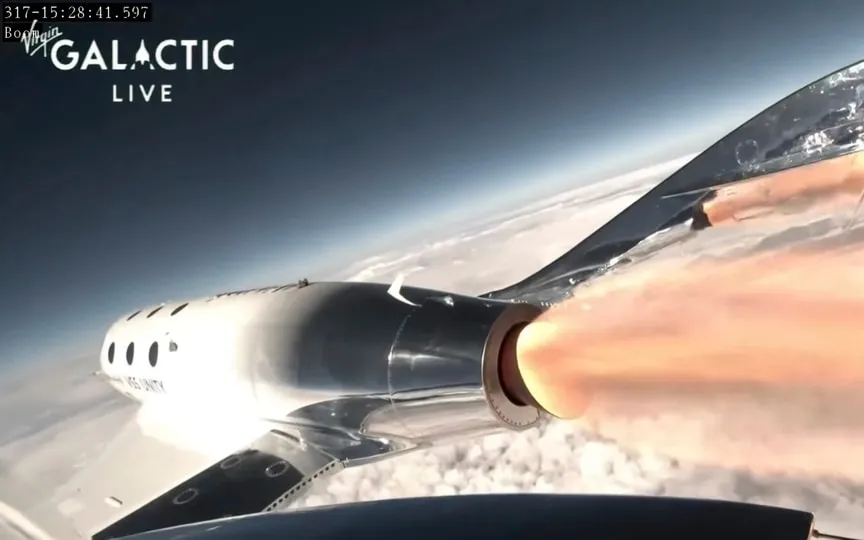Virgin Galactic Achieves Historic Milestone with Successful Space Flight
Virgin Galactic Holdings Inc. achieved a significant milestone as it successfully transported paying customers to the outer limits of space, marking a major accomplishment for the company established by Richard Branson nearly twenty years ago.
The VSS Unity spacecraft reached space around 9:30 a.m. local time in New Mexico, Virgin Galactic revealed the event live on its website Thursday. It happened about an hour after takeoff, with six people on board, including researchers from the Italian Air Force and the Italian National Research Council.
The commercial debut officially brings Virgin Galactic into the ranks of space tourism providers, joining the likes of Elon Musk’s SpaceX and Jeff Bezos’ Blue Origin LLC. Virgin Galactic has said it plans to move to a regular monthly commercial flight soon, bringing in much-needed revenue.
Although the company has carried employees on several previous test missions, the latest launch was the first for ticket-owning passengers. It will be Virgin Galactic’s highest flight since Branson flew to the edge of space in 2021.
“This is a big deal,” Mike Moses, Virgin Galactic’s director of spaceflight missions and safety, said in an interview before the launch. “That’s what we were set up to do.”
It’s coming much later than planned: Virgin Galactic began operations in 2004 and had hoped to carry tourists into space as early as 2008. Over the years, the company has endured numerous delays and setbacks, including fatal accidents, regulatory investigations and lawsuits. The company has lost hundreds of millions of dollars annually since it went public in 2019, but generates only nominal revenue.
Despite the successful mission, Virgin Galactic’s often-volatile stock tumbled on Thursday, raising new questions about its business model. Shares were down 9.8% at 12:19 p.m. In New York.
The company is now under pressure to realize Branson’s dream of offering regular space travel missions. Virgin Galactic has a narrower focus than competitors with other sources of revenue, such as satellite launch services or cargo deliveries to NASA.
“Branson founded Virgin Galactic almost 20 years ago,” said Caleb Henry, director of research at space consultancy Quilty Analytics. “He has been very patient in trying to make this business a success. I would say there will come a time when they really have to act.”
Thursday’s flight, called Galactic 01, provided the crew with an opportunity to conduct experiments and test payloads in the space environment. The passengers were Walter Villadei and Angelo Landolfi from the Italian Air Force and Pantaleone Carlucci, an engineer from the Italian National Research Council. They were joined by Virgin Galactic employee Colin Bennett and two pilots.
The company’s primary vehicle is its VSS Unity, which is carried aloft under the wing of the unusual twin-body VMS Eve aircraft. When the pair reaches an altitude of 46,000 feet, the space plane will detach and ignite a hybrid rocket engine that will propel it into space. The craft typically reaches an altitude of just over 50 miles, where the crew can see the curvature of the Earth from the darkness of space before gliding back to the runway.
Virgin Galactic has had lofty goals for this spaceflight model. In its early days, the company took deposits from A-list names including Ashton Kutcher, Justin Bieber and Leonardo DiCaprio. Tickets were initially going for a quarter of a million bucks apiece before going up.
But Virgin Galactic faced serious setbacks during development. In 2007, three workers at Scaled Composites, a contractor started by aerospace entrepreneur Burt Rutan, died during an engine test on a Virgin Galactic spacecraft. In 2014, one pilot was killed and another injured when a Virgin Galactic vehicle crashed during a test flight. The company acknowledged that some customers canceled their reservations as a result of the accident for various reasons.
Still, Mooses said that most of the customers have stayed. “These people have been patient for a long time.”
Virgin Galactic had a major milestone in 2018 when it reached space for the first time by sending two crew members to an altitude of 51 miles. It has since sent several manned test missions into space.
In 2019, the company was listed on the stock exchange through a reverse merger with a specialized trading company, using a blank check boom to replenish its coffers. At the time, Virgin Galactic predicted that commercial operations would begin soon and that it would fly more than 1,500 customers a year by 2023.
The company appeared to be nearing a breakthrough in 2021 when it launched its billionaire into space. The high-profile flight grabbed headlines around the world as Branson beat Bezos, but it soon emerged that the mission had deviated from the planned flight path, prompting a brief investigation under the supervision of the US Federal Aviation Administration.
Virgin Galactic continued to suspend commercial operations for more than a year while it upgraded the vehicle. During that time, it also fought in lawsuits for things like disclosure of information. And it burned through cash — about $400 million last year alone.
“It’s not a healthy way to run a company in the long term,” said Henry Quilty of Analytics. “It is not a healthy way to run a company in the medium term. It’s something you want to get rid of as quickly as possible.”




